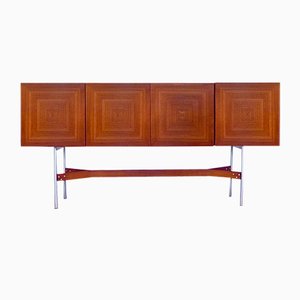
Furniture manufacturer Fristho was one of the most prominent Dutch furniture makers in the 1950s and ‘60s, alongside Pastoe, Artifort, Gispen, and ‘t Spectrum. The company was established in 1921 as Friesche Stoel-en Houtwarenfabriek (Friesian Chair and Wood Factory), referred to as Fristho for short, in the town of Franeker. It is unknown who established the factory, however, it is confirmed that in the beginning, the factory produced wooden chairs for the domestic market.
In the early 1950s, Fristho sought out young designers eager to embrace new styles, including the American designer William Watting, German designer Rudolf Glatzel, and Danish designer Inger Klingenberg (1932-1997). Watting’s 'Modern Art' collection, in particular, sparked Frishto’s new direction in furniture with Scandinavian influences. In 1956, Fristho appointed Chinese-Dutch designer Kho Liang Ie (1927-1975) and graphic designer Wim Crouwel to lead the company in a new direction characterized by innovation and modernist values. This collaboration resulted in a collection of furniture that included the JDL 225 Sideboard (1956). The sideboard was deemed too avant-garde for contemporary audiences, resulting in a relatively short period of production. Internationally, however, the sideboard was well-liked, and the collection was subsequently licensed by Arflex in Milan.
Throughout the 1950s and ‘60s, Fristho became very successful producing a wide range of modernist furniture - spanning sideboards, wall units, coffee tables, and dining tables - that became representative of postwar European design. These designs reflected a new era of consumer prosperity and technological progress, using prefab materials for the production. Notable designs include Klingenberg’s IK Chair (1950s), which featured a timeless modern construction, it produced until the late 1970s; Liang Ie’s J Series (1956-60) and Copal Series (1960-1963), both of which found immense commercial success; and Glatzel’s G-Series Sideboard (1962), which was on display at the "Fries Design: Fristho" exhibition in the Netherlands in 2014.
By the 1970s, Fristho sold their furniture in cities such as Los Angeles, Paris, and Milan. In the late 1970s, due to the economic crisis in the Netherlands, Fristho suffered financially and the factory closed its doors forever in 1978. Today, the vintage pieces produced in the 1950s up until the ‘70s are popular on the vintage market, praised for their postwar aesthetic.

